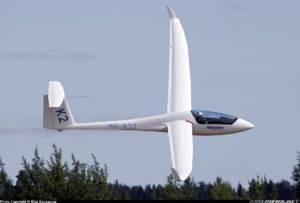PlaneSpottingWorld welcomes all new members! Please gives your ideas at the Terminal.
Schempp-Hirth Ventus-2
| Ventus 2b being winch-launched at Lasham airfield. | |
| Type designation | Ventus-2 |
| Competition class | 15 metre and 18 metre |
| Crew | 1 |
| Number built | 168 (2a& 2b) 459 (2c, cT & cM) |
| Length | 6.35 m (Ventus-2a) 6.41 m (Ventus-2ax) 6.58 m (Ventus-2b) 6.81 m (Ventus-2bx, 2c, 2cx) |
| Height | 1.30 m |
| Cockpit width | 0.54 m (Ventus-2a) 0.62 m (Ventus-2b, 2c) |
| Cockpit height | 0.75 m (Ventus-2a) 0.81 m (Ventus-2b, 2c) |
| Wingspan | 15 m (Ventus-2a, 2b) 15 / 18 m (Ventus-2c) |
| Wing area | 9.67 m² (15 m) 11.03 m² (18 m) |
| Aspect ratio | 23.3 (15 m) 29.5 (18 m) |
| Empty mass | 230 kg (Ventus-2a) 235 kg (Ventus-2b) 290 kg (Ventus-2c) 310 kg (Ventus-2c 18m) |
| Water ballast | 200 kg |
| Maximum mass | 525 kg (15 m) 600 kg (2cxT) |
| Wing loading | 31 – 54.3 kg/m² (Ventus-2a) 32 – 54.3 kg/m² (Ventus-2b) 37 – 54.3 kg/m² (Ventus-2c) 35 – 51.2 kg/m² (Ventus-2c 18 m) |
| Maximum speed | 270 km/h (Ventus-2a, 2b) 285 km/h (Ventus-2c) |
| Rough air speed | 180 km/h (Ventus-2a, 2b) |
| Stall speed | 79 km/h (Ventus-2c at MAUM) |
| Minimum sink rate | ca. 0.51 |
| Empty mass | 305 kg (engine removed, 15 m) 325 kg (engine removed, 18 m) 335 kg (engine installed, 15 m) 355 kg (engine installed, 18 m) |
| Engine type | Solo 2625 2-stroke |
| Engine power | 15.3 kW at 5500 rpm |
| Fuel capacity | 13 litres |
| Climb rate | 0.9 m/s (ISA, MAUM) |
| Range | 370 km in 'saw-tooth' operation |
| Empty mass | 320 kg (engine removed, 15 m) 340 kg (engine removed, 18 m) 395 kg (engine installed, 18 m) |
| Engine type | Solo 2625-01 2-stroke |
| Engine power | 38 kW at 6000 rpm |
| Fuel capacity | 13 litres (fuselage tank) 39 litres (wing tanks) |
| Climb rate | >3 m/s (ISA, MAUM) |
| Range | 840 km in 'saw-tooth' operation |
The Schempp-Hirth Ventus-2 is a sailplane produced by Schempp-Hirth since 1994. It replaced the highly successful Schempp-Hirth Ventus.
The Ventus-2a and 2b are 15 metre sailplanes. The 'a' version has a narrow fuselage and the wider fuselage version is called the 2b. Winglets are used with these models. The 18 metre span Ventus-2c was introduced in 1995 but was almost an entirely different aircraft with a different fuselage and wings, but it has the option of shorter tips with winglets to fly as a 15 metre glider.
From 2003 the Schempp-Hirth Discus-2 fuselage was used for all versions, which now have the designations 2ax, 2bx and 2cx. Flight tests in 1996 showed that the 15 metre version had a glide angle of 46:1 but only after considerable work on sealing gaps and by using turbulators.
The narrow Ventus-2a has been highly successful in competitions with consecutive World Championship wins from 1995 to 2003.
Some Ventus-2c and 2cx are fitted with small sustaining engines (turbos) and are designated with a T suffix, while some are self-launching and have the suffix 'M'.
Sources
Lists relating to aviation | |
|---|---|
| General | Timeline of aviation · Aircraft · Aircraft manufacturers · Aircraft engines · Aircraft engine manufacturers · Airports · Airlines |
| Military | Air forces · Aircraft weapons · Missiles · Unmanned aerial vehicles (UAVs) · Experimental aircraft |
| Notable incidents and accidents | Military aviation · Airliners · General aviation · Famous aviation-related deaths |
| Records | Flight airspeed record · Flight distance record · Flight altitude record · Flight endurance record · Most produced aircraft |


